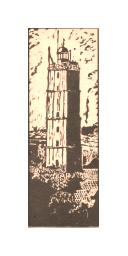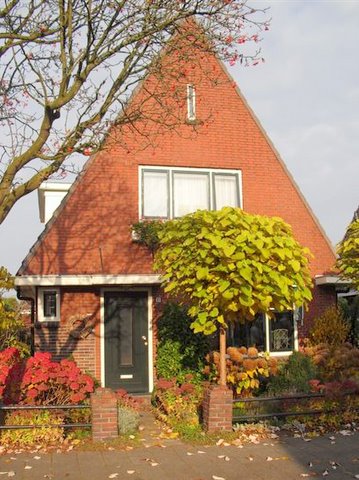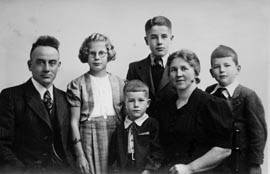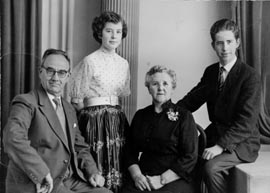
Hinne de Jong
A Chronicle
translated/arranged by his son, Sense de Jong
The war years (1940-1945)
- 1: Introduction
- 2: Captain Pieter
- 3: Childhood years
- 4: Shipwreck
- 5: Teenager
- 6: Spring remembered
- 7: That's how it was
- 8: Pre World War I
- 9: Mobilization (1914-1918)
- 10: Boys will be boys
- 11: Hinne leaves Terschelling
- 12: Hinne meets his true love
- 13: An eventful move
- 14: A serious illness
- 15: The war years (1940-1945)
- A1: Memories of Pa (by Truus)
- A2: Memories of Moe (by Truus)
- A3: Pa talks again
- A4: Cornelis Jacob de Jong
Another site by Sense de Jong:
~ Sense de Jong ~
Reminiscences
Sites by Henry de Jong:
~ Herman de Jong ~
Memorial
~ Newmaker Notes~
Writings, Pictures, Collections
~ AACS/ICS Niagara Conferences~
1970 - 1991
Early in the morning of May 10, 1945, Germany invaded the Netherlands. What many hoped would not happen overwhelmed Holland with all its terrible consequences.
Hinne recalled how between 4 and 5 a.m., he heard low-flying airplanes over the City of Winschoten. Everyone rushed out of bed, of course. Someone opened the front bedroom window, located just next to 5-year-old Sense’s bed. Yes, there were the planes with the German Iron Cross clearly visible.
Next to Acacialaan 15 lived a member of the NSB (National Socialistic Bond - a very pro-Nazi organization). He was asked what was going on. He said that Holland was in a state of war with Germany. The man was probably the least surprised on the street.

Acacialaan 15, Winschoten, The Neth. - our parental home.
No one thought of going to work that day. It became clear that Holland would not take the invasion lying down. Hinne wrote that many bridges across key waterways were blown up or put out of action.
The Acacialaan was close to the “Meststraal” bridge across the “Winschoter Diep,” the canal that then ran right through town. Restless, Hinne needed to find out what was going on and walked towards the canal. Arriving there the bridge blew up no more than 50 meters away from him. Fortunately, he was unhurt and rushed home. Someone said: “Didn’t you hear the announcer asking you to stay indoors?” Hinne’s deafness was probably to blame. He had already been wondering why it was so quiet by the bridge.
But then everyone realized that Truus was nowhere to be found. Hinne rushed out again to find her. Eventually, Truus and her girl friend were found by the “Beertsterbrug,” another bridge across the canal. It was still in one piece. Was it about to be blown up?
Hinne wrote that he chased the girls away from there. He also saw a group of Dutch soldiers standing nearby. But, in the distance -close by the large potato factory “Reiderland” - he saw German soldiers marching towards the canal.
One of the Dutch soldiers was overheard saying to his buddy: “Before we get out of here, I want to shoot one of those Nazis.” He must have been a good marksman, wrote Hinne, because he hit the German commandant in the head. He died instantly.
Furious, the Germans entered the factory office and forced bookkeeper Leunink outside and ordered him to walk ahead of the troops into Winschoten.

Meanwhile, a small group of Germans had simply walked along the railroad from Nieuwe Schans (next to the border) to the train station in Winschoten. Members of the Dutch army still in town then left towards the West, via Heiligerlee. They knew they were no match for the German war machine.
Even though many bridges had been blown up, the Germans nevertheless made quick progress entering such places as Veendam and Zuidbroek. Hinne wrote: “It was obvious that they had inside information and knew beforehand where to go and how to get there!” German intelligence? Fifth column (NSB) inside Holland? Who knows!
Trying to survive....
Hinne didn’t write at length about the war years. He never even mentioned that the kids were forced by the Germans out of the “Hoogkleischool,” the Christian Elementary School in Winschoten. The Germans simply requisitioned that school and others for living and sleeping quarters. The school boards made other arrangements. For example, Herman and Sense were transferred to the “Oudewerfslaan School.” Where did Cees and Truus go?
Hinne is silent about the requisitioning of radios, bikes, etc. He did write about how the Germans ordered him and other men from Winschoten to dig trenches along the important road to Blijham. It was called “putjes graven,” (digging holes) and was part of a German program called, “Organisation Todt.” After doing this back-breaking work for a few days, he was visited by a Mr. Kruisselbrink, an inspector employed by Hinne’s employer (NHM). Kruisselbrink simply said: “Come with me, de Jong. We need you. Let others do that work!”
The welfare of his family was much on Hinne’s mind. He wrote extensively about efforts to smuggle extra rations into Winschoten from the farmlands. The NHM had many dealings with well-to-do farmers all over the province. And that’s how Hinne had many opportunities to provide his loved ones with such precious food as wheat, oats and rapeseed.
From rapeseed much-needed oil was made with the help of a grinding machine. But where to find such a machine? Herman and Sense were asked to provide leg power. With the curtains closed and with candles burning, they took turns sitting on a bike contraption that turned the grinder and produced cooking oil for their Mom.
One day, Hinne and his NHM boss, head supervisor van Rozen, ventured into northern Groningen to a place called Uithuizen. They were on a mission. They returned with three hectolitres of rapeseed. They made it back home.
Hinne went there again, traveling by steam tram. He obtained a suitcase full of rapeseed. On the way back, he was told the Germans were checking everyone ahead. But they never checked Hinne that day. On the train to Winschoten he again was told to expect a German check at the train station in his home town. Hinne then decided to leave the train in Hoogezand and bring the suitcase to the family Eigenberg living close to the station there. These people were friends - they had been neighbours on the Acacialaan one day. Later, Hinne retrieved his suitcase by going to Hoogezand on his bike.
*****************************
(COMMENT - Believe it or not, this is the end of Hinne’s Chronicles. We, as children, could never figure out why he had stopped here. There was so much more to tell. In the 1950s, first Truus and her husband John Boot, then Sense, then Herman, left for Canada. In the 1960s, Cees and his wife, Jannie, and kids left for Canada as well, settling in Sarnia, Ontario. Only Jaap and Hennie stayed at home and moved with them from Winschoten to “Stad” Groningen. Since we emigrated, numerous trips were made Holland to visit them. And they visited us in Canada on a number of occasions.
Our photo albums tell the stories. Our parents died and are buried in a Groningen cemetery called “Selwerderhof.”


From l. to r.: Pa, Hennie, Moe and Jaap. The older kids had left for Canada during the 1950s.
I’ve decided to close Hinne’s Chronicles with a number of addenda. The first two stories are contributions by my sister Truus about our Pa (Dad) and our Moe (Mom). The third story is mine. It has a serious as well as a humorous side to it. I’ve also included an “In Memoriam” in connection with the life and death of another Cees de Jong. I did not know him personally. He was a son of Oom Jaap, Hinne’s brother. He, like many other de Jongs, chose to become a seafarer. They went through a lot and this story explains it well. Finally, I’ve added an adaptation of a short, moving story about “Children of the Island” written by the well-known Dutch author Cor Bruijn. It is entitled: “Neeltje and Iemke.” Read it to your grandchildren sometime, will you? - Sense)
[an error occurred while processing this directive]